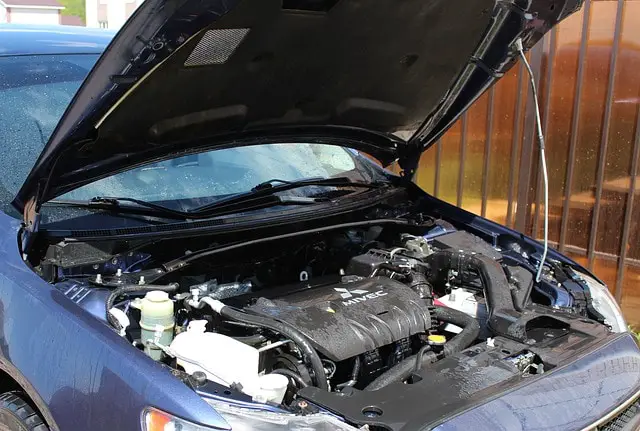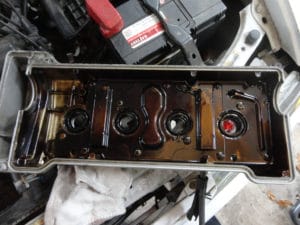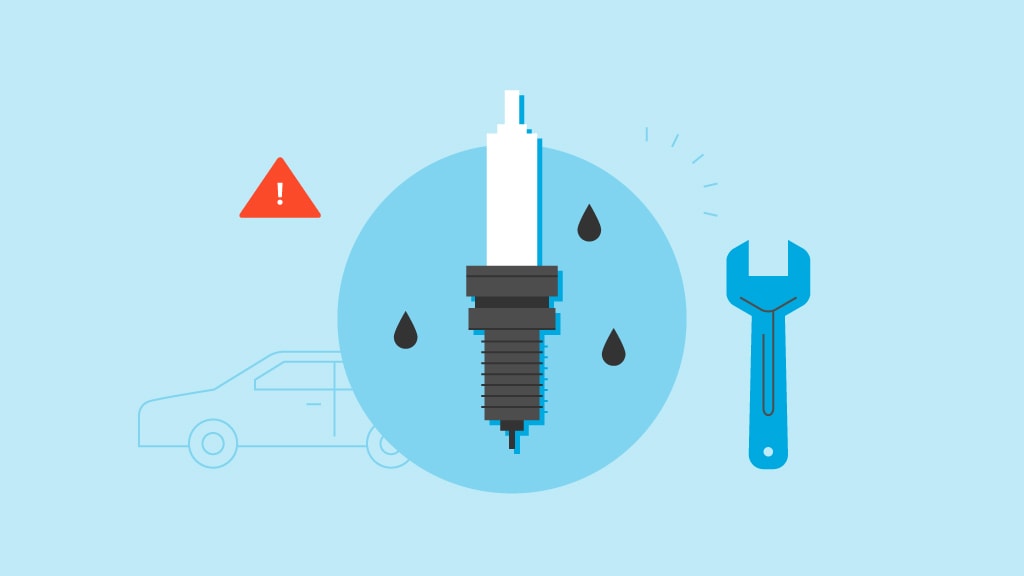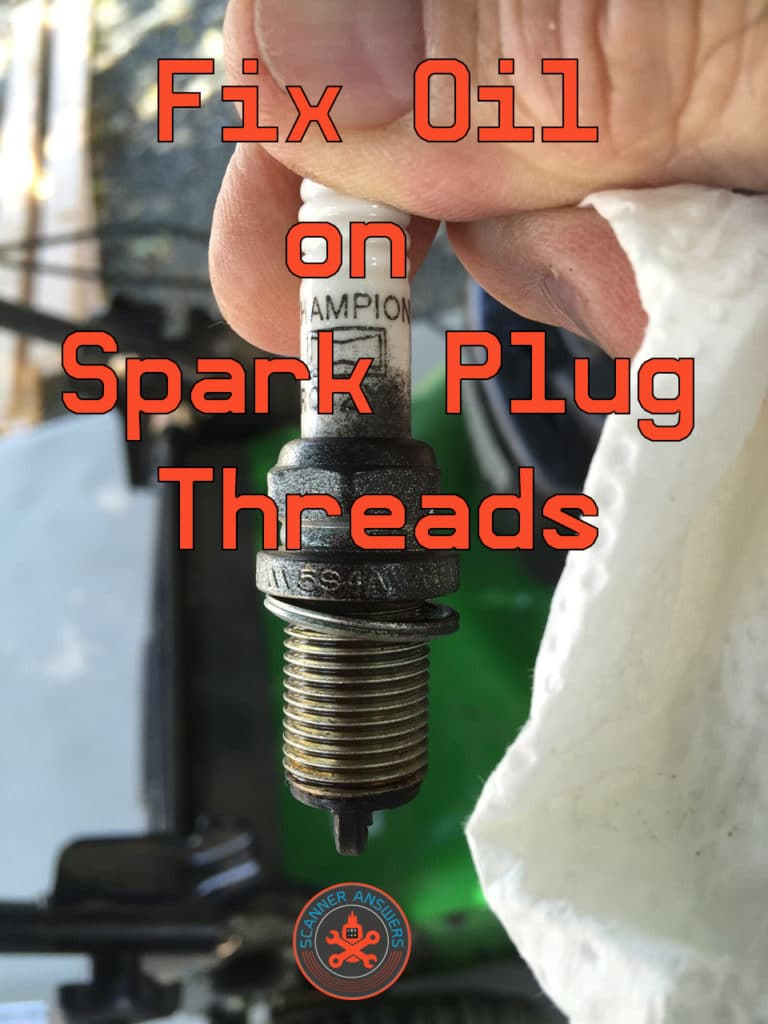Have you just discovered some black liquid on your spark plugs?
This problem is fairly common on older cars. I’m talking about oil on the spark plug threads.

If you’re a DIY type of car owner, you probably know what I’m talking about here. Are you wondering why is there oil on the spark plugs after removing them? You have come to the right place. This article will tackle the causes of oil on spark plugs including the symptoms to look out for and how to fix it without draining your wallet.
Most of the time you’ll see that pesky CEL, or Check Engine Light come on. If it does, make sure you pick up an OBD2 code reader to help you diagnose the problem!
Hi there I’m Matt. You might be wondering why are my spark plugs wet with oil? Read on my friend.
I used to spend a lot of time tinkering with my older rides. You will always find me propped under the hood and trying to fix things like cleaning the throttle body, refilling the engine fluids like engine oil, ATF, and brake fluid, and replacing or cleaning the spark plugs. I had this old Mitsubishi Eclipse that had oil on the spark plug threads. Now mind you, that car was not the kind of vehicle that is pampered and kept in an isolated garage. It was one of my first cars I had in high school and I drove it like I stole it, haha.
The first thing I would do when troubleshooting this problem is to remove the plugs, wipe off the oil, and re-insert again.
Start the motor, go for a short ride, and shut off the motor to let it cool. I would then remove the spark plugs once more to check for the presence of oil. If I still find oil in the spark plug threads (in the absence of engine malfunction such as sputtering or misfires), it could only mean one thing: it is time to inspect and replace the valve cover gasket and the O-ring spark plug tube seals.

Oil on Spark Plugs Symptoms and Car Problems
Like I said at the beginning of this article, finding oil on the spark plug threads is a common problem on older cars. It could also happen to newer cars that are constantly driven with a heavy right foot. But one of the reasons why this sort of problem occurs is due to dirty oil. Sludge, dirt, crud, or dirty oil has a tendency to burn the valve cover gaskets and O-ring seals over time. But a leaking valve cover gasket might just be the tip of the iceberg. Other problems that can cause leaking oil in the spark plug threads includes:
- Faulty piston compression rings. The pistons inside your engine are equipped with compression rings to prevent oil from entering the combustion chamber. If the piston rings are cracked or faulty, the engine oil will most likely leak inside the spark plug wells. The most common symptom of cracked compression rings is a foul-smelling and bluish exhaust smoke.
- Worn out valve guides. If you notice oil or ash in the spark plug wells, it is time to check the condition of the valve guides. Worn out or faulty valve guides can also cause excessive blue smoke from the exhaust. The valve guides inside your engine are designed to regulate the air intake and will keep the valves in place as you rev the motor. If the valve guides are leaking, oil can enter the spark plug wells.
Both of the conditions mentioned above are pretty serious and will need to be fixed immediately. Sadly, replacing the piston rings and the valve guides are not a simply DIY job. In the presence of oil on the spark plug threads and bluish smoke from the exhaust, it is better to have the engine checked by a professional mechanic.

Is it bad to have oil on the spark plug threads?
Yes, for lack of a better answer. Although finding oil on the spark plug threads will not exactly lead to engine seizure or extensive engine damage, continued operation might result in warped pistons and broken valves. There is also a possibility of engine fire if the spark plugs are able to ignite the oil. Your vehicle might also fail the smog test if the problem is not rectified. In some cases, leaking oil inside the spark plug wells might damage the head gasket in the long run.
How will I know if the valve cover gasket is bad?
Most of the valve cover gaskets in modern cars are constructed from plastic, cork, or silicone. The material acts as a seal between the valve cover and the cylinder head and is prone to leaking once the gasket brittles with age. Here are some of the most obvious oil on spark plugs symptoms that will help you determine is the valve cover gasket is bad:
- The presence of oil on the spark plug threads
- Dirty valve cover gasket caused by leaking oil
- Engine misfire or diminished engine performance
- Engine is always low on oil due to excessive oil consumption
- The smell of burning oil as you start the motor or drive the vehicle
How much does it cost to replace a valve cover gasket?

It will all depend on the make and model of your vehicle. It will also depend on the engine size. Vehicles equipped with relatively smaller engines will be much cheaper to replace compared to a V6 or V8 motor. You can expect to spend anywhere between $100 to as high as $700 to replace a valve cover gasket, and this includes labor and parts.
If you want to save money, you can always do it yourself, although this is only applicable if you have moderate technical knowledge about engine repair. All you have to do is to buy a replacement valve cover gasket and O-ring spark plug tube seals to correct the problem. They only cost like $20 bucks, but the real expense is how much time it takes to do the repair.
How to Fix Oil on Spark Plug Threads By Replacing the Valve Cover Gasket
Materials Needed:
- New valve cover gasket and O-ring spark plug tube seals (preferably silicone)
- Ratchet and basic socket set
- High-temperature engine sealant
- Flathead screwdriver
- Brake cleaner to clean the valve cover

Step 1: Remove the valve cover.
Depending on the engine type, you will need to remove the bolts around the valve cover. On some engine models the valve cover can be easily removed by removing the large nuts on the spark plug holes.
Remove the spark plug wires/high tension wires/ignition coils on top of the valve cover. Disconnect any hoses or wiring harnesses on the valve cover before loosening and removing the bolts.
Grab a flathead screwdriver and gently pry off the valve cover. After removing the valve cover, you can easily remove the worn out spark plug seals.
Step 2: Clean the underside of the valve cover.
The underside of the valve cover will be filled with dirt and oil. You can clean it by using a can of brake cleaner. Simply spray a bit of the cleaner to remove excess oil and sludge on the valve cover and wipe clean with a towel or cloth.
Step 3: Install the new valve cover gasket.
Check the new valve cover gasket and make sure it conforms to the shape of the valve cover. Simply install it and apply engine sealant on the sides and allow to dry for at least 15 minutes. The engine sealant will help to keep the valve cover in place as you install it over the cylinder head. It will also ensure a tight and perfect seal to prevent oil leaks.
Step 4: Reinstall the valve cover gasket over the engine.
After the sealant is dry, you can go ahead and reinstall the valve cover gasket on the engine. Simply reinstall the bolts and tighten sufficiently.
Step 5: Install the new spark plug seals.
Now is the time to install the new spark plug seals. Simply apply a bit of sealant under the new seals and place them over the spark plug tubes. After doing so, you can go ahead and reinstall the spark plug nuts and tighten by hand. Grab the ratchet and socket set and tighten the nuts properly.
You’re almost done. The last thing you need to do is to reinstall the spark plug wires and the hoses on the valve cover. Make sure to clean any oil spills or oil stains on the exhaust manifold and surrounding areas with brake cleaner before starting the motor.
You can replace worn out valve cover gaskets and seals even without removing the spark plugs. I personally prefer to remove the spark plugs while replacing the gaskets and seals for good measure. Do not forget to reinstall and tighten the spark plugs before putting back the spark plug wires on top of the valve cover.
Now, start the engine and allow to warm up for 5 to 10 minutes. Make sure to change the oil according to the recommendations on the owner’s manual to prevent crud and sludge.
Read about our favorite synthetic motor oil comparison chart. You’ll also want to get an oil drain pan for this job!
Conclusion
Having oil on the spark plug threads is not the end of the world. Always check for accumulated oil or dirt on the sides of the valve cover after each oil change. If you find oil leaks, it is better to replace the gaskets and seals immediately to prevent expensive engine damage.
If you’re spark plugs are worn down, now may be a good time to replace them with some performance spark plugs, like some Denso’s or NGK’s.

